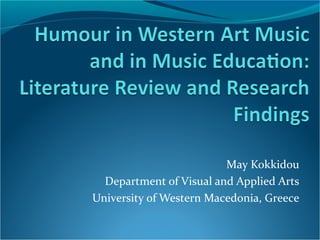Kokkidou humour in western art music and in music1
- 1. May Kokkidou Department of Visual and Applied Arts University of Western Macedonia, Greece
- 2. How does musical humor affect children's willingness to listen to music? How does musical humor influence children's attitudes and activities?
- 3. Since the time of Aristotle, philosophers and scholars have tried to understand and explain the origins and the functions of humour and laughter. According to Abraham Maslow (1968) humour is a supreme manifestation of the human spirit, a peak experience, a way of bringing delight to the heart; it is not driven by other needs but is linked to the disposition to play.
- 4. Humour in music is closely linked to its parodic or comic elements.
- 5. A common argument against the existence of musical humor is that in most instances which provoke smiles or laughter, this does not appear to lie in the musical sounds themselves but in the associated ideas, that is in extra-musical factors.
- 6. Can pre-school pupils appreciate humour in music? If so, how do they perceive and interpret music as humorous? Does the understanding of musical humour depend on prior experience?
- 7. About the study ?Samble: 25 children of pre-school age, 4 to 6 years old ?Time: April and May 2011 ?Instrument: Interviews ?Procedure: Five pieces of music for listening. The students were asked two questions: “Is this music funny?” and “Why?”
- 8. Music pieces /passages ?the opening of the first movement of Kodaly's Háry János suite ?the first movement of Eine Kleine Nichtsmusik by P.D.Q.Bach (Peter Schickele) ?People With Long Ears from Camille Saint-Sa?ns's Carnival of the Animals ?the first part of Richard Strauss's Till Eugenspiel's Merry Pranks ?The third movement of Bizet's Jeux d’ enfants (the Spinning Top)
- 9. The students did not react with laughter to any of the pieces on a first listening. Nevertheless, after hearing explanatory information they showed perception of the humour in the music, laughed spontaneously and even at such length as to prevent them from following the development of the work
- 10. Discussion Laughter is not a spontaneous response to music: searching for and discovering the humorous dimension in music has to do with searching for and discovering analogies in real life
- 11. The perception of humour or its implications in music requires additional cognitive stimuli
- 12. Children are able to appreciate humour in music, which demonstrates their ability to use metaphor and comparison in order to proceed to symbolic interpretations
- 13. A humorous element provides motivation for a closer relation with a work of music
- 14. Existing knowledge and previous experience have a supplementary function, facilitating the perception of musical humour
- 15. The findings of our research showed that children aged 4 to 6 can be aware of musical humor, though within a referential context
- 16. May Kokkidou















